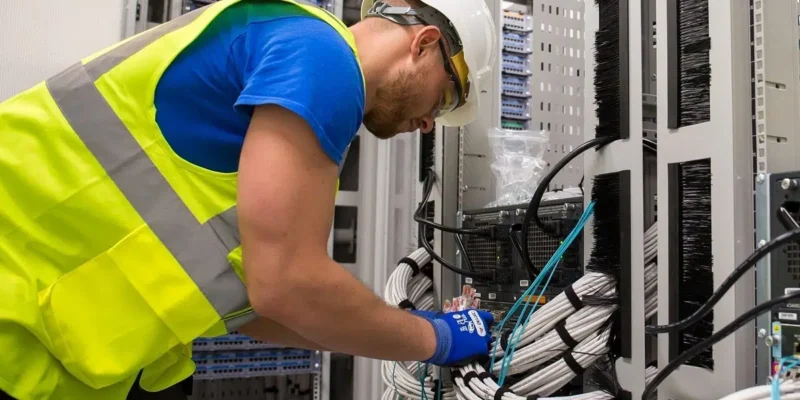In today’s rapidly evolving technological landscape, homes & offices became digital hubs where a multitude of smart devices and technologies seamlessly interact to enhance our daily lives. This interconnected ecosystem relies heavily on network cabling, which serves as the backbone for efficient communication, data sharing, and automation.
The Expanding Universe of Home Technologies
The modern home has witnessed a remarkable transformation, thanks to the proliferation of smart technologies that offer convenience, security, energy efficiency, and entertainment.
Smart automation systems allow homeowners to control various aspects of their homes remotely. This includes smart thermostats for climate control, smart lighting for energy efficiency, and voice-activated assistants like Amazon Alexa and Google Home that can control multiple devices with simple voice commands.
But all of these and other devices need to be connected. Even when a device is wireless, there is still a cable enabling connection of the device, or its base. This is where network cabling services come in.
- Home Security – Advanced home security systems encompass smart doorbell cameras, motion sensors, and surveillance cameras that provide real-time monitoring and alerts. These systems are integrated with smartphones, enabling homeowners to keep a watchful eye on their property from anywhere.
- Entertainment – Home entertainment systems have evolved to include smart TVs, streaming devices, and high-quality sound systems that deliver immersive experiences. Streaming services like Netflix, Hulu, and Disney+ have revolutionized how we consume content.
- Home Office – Remote work has surged in popularity, and home offices have become a necessity. Home technologies facilitate seamless communication and collaboration through video conferencing tools, high-speed internet connections, and ergonomic setups.
- Energy Efficiency – Smart thermostats, LED lighting, and energy-efficient appliances are reducing energy consumption and costs. These technologies can be controlled remotely, allowing homeowners to optimize energy usage even when away from home.
- Health and Wellness – Health-focused technologies, such as fitness trackers, smart scales, and telehealth platforms, enable individuals to monitor their health and well-being from the comfort of their homes.
The Crucial Role of Network Cabling
Behind the scenes, network cabling serves as the unifying force that ties these diverse home technologies together. Whether it’s streaming 4K content, securing your home with smart cameras, or remotely adjusting your thermostat, network cabling ensures that data flows smoothly between devices and systems. Network cabling is the cornerstone of the modern digital home and office.
Network cabling provides a reliable and stable connection that is less susceptible to interference compared to wireless connections. This is essential for applications like video conferencing, online gaming, and smart home automation, where a stable connection is paramount.
As home & commercial technologies become more data-intensive, high-speed network cabling is crucial. Cat 5e, Cat 6, and Cat 6a cables provide the necessary bandwidth to support gigabit Ethernet and beyond, ensuring seamless data transmission.
Network cabling offers low latency, minimizing delays in data transmission. This is especially critical for real-time applications like online gaming and video conferencing, where even minor delays can impact the user experience.
Wired connections are inherently more secure than wireless ones, as they are less susceptible to hacking and interference. This is particularly important for protecting sensitive data and ensuring the security of home automation systems.
It is scalable. Network cabling allows for easy scalability as new devices and technologies are added to the home network. Additional ports can be activated, and structured cabling systems can accommodate future growth.
In addition, network cabling ensures comprehensive coverage throughout the home, eliminating dead zones or areas with weak signal strength that are common in wireless networks.
Types of Network Cabling in Home Technologies
Several types of network cabling are commonly used in home technologies, each with its own characteristics and applications –
- Ethernet Cables – Ethernet cables, also known as twisted-pair cables, are the most common type of network cable. They are available in various categories (e.g., Cat 5e, Cat 6, Cat 6a) and are used for both residential and commercial networks. Ethernet cables are known for their versatility and reliability.
- Fiber Optic Cables – Fiber optic cables use thin strands of glass or plastic to transmit data as pulses of light. They offer significantly higher data transfer rates and can span longer distances compared to copper cables. Fiber optics are ideal for high-speed internet connections and connecting devices in different parts of the home.
- Coaxial Cables – Coaxial cables are often used for cable television (CATV) and broadband internet connections. They consist of a central conductor surrounded by layers of insulation, shielding, and an outer insulating layer. Coaxial cables are known for their durability and resistance to interference.
- Powerline Adapters – Powerline adapters allow network data to be transmitted over existing electrical wiring in the home. They are a convenient solution for extending network coverage to areas with limited access to traditional cabling.
- Wireless Technologies – While not traditional network cabling, wireless technologies such as Wi-Fi and Bluetooth play a crucial role in home networking. They provide flexibility and mobility, allowing devices to connect to the network without physical cables.
The connected home & office of tomorrow will continue to evolve as new technologies emerge and our reliance on interconnected devices grows. Security cameras, access control systems, WiFi access points and other devices all need network cables today. However, even in the future technologies will likely still rely on network cables in one way or another.














Comments